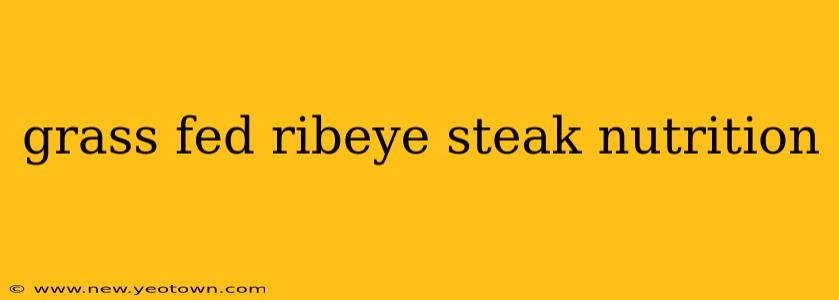The aroma alone is enough to make your mouth water. A perfectly seared grass-fed ribeye steak, juicy and tender, is a culinary delight. But beyond its incredible taste, this cut of beef boasts a nutritional profile that deserves a closer look. Let's dive into the world of grass-fed ribeye nutrition, exploring its benefits and answering some common questions.
Imagine this: you're sitting down to a meal, savoring each bite of a succulent grass-fed ribeye. The rich flavor is satisfying, and you know you're nourishing your body with high-quality protein and essential nutrients. That feeling is exactly what makes grass-fed ribeye so appealing to health-conscious individuals.
What are the nutritional benefits of grass-fed ribeye?
Grass-fed ribeye stands out due to its superior nutritional profile compared to conventionally raised beef. The difference stems from the cattle's diet. Cows raised on pasture consume a diet rich in diverse grasses, herbs, and other plants. This natural diet translates to a steak packed with beneficial nutrients.
Compared to grain-fed beef, grass-fed ribeye often contains:
- Higher levels of Omega-3 fatty acids: These healthy fats are crucial for brain health, reducing inflammation, and supporting heart health.
- More conjugated linoleic acid (CLA): This fatty acid is associated with numerous health benefits, including improved insulin sensitivity and reduced risk of certain cancers.
- Higher levels of Vitamin E: A powerful antioxidant that protects cells from damage.
- More antioxidants: Grass-fed beef generally contains a higher concentration of antioxidants compared to grain-fed beef, contributing to overall health and well-being.
- More Vitamin A and Beta-Carotene: Crucial for vision, immune function, and cell growth.
Is grass-fed ribeye higher in cholesterol than grain-fed?
This is a common question, and the answer isn't as straightforward as a simple yes or no. While both grass-fed and grain-fed ribeye contain cholesterol, the impact on your cholesterol levels is complex and depends on various factors, including your overall diet and individual health. The cholesterol found in food doesn't always directly translate into higher blood cholesterol levels. Focusing on a balanced diet and regular exercise is more critical than solely focusing on dietary cholesterol.
How many calories are in a grass-fed ribeye steak?
The calorie count varies depending on the size and cut of the steak. Generally, a 3-ounce serving of grass-fed ribeye can contain anywhere from 180-250 calories. It's essential to consider the cooking method as well; adding excessive butter or oil during cooking will increase the overall calorie content.
What are the potential downsides of eating grass-fed ribeye?
While grass-fed ribeye offers many benefits, there are a few points to consider:
- Cost: Grass-fed beef typically costs more than conventionally raised beef due to the higher costs of raising cattle on pasture.
- Availability: Finding grass-fed ribeye may be more challenging depending on your location. You may need to visit specialty butchers or farmers markets.
- Saturated Fat: While containing healthy fats, grass-fed ribeye is still a source of saturated fat, so moderation is key as part of a balanced diet.
How much grass-fed ribeye should I eat per week?
The recommended amount of red meat consumption varies depending on individual health needs and dietary preferences. Consult your doctor or a registered dietitian for personalized advice. As with any food, moderation is essential.
Is grass-fed ribeye better for the environment?
Yes, generally speaking, grass-fed beef is considered to be more environmentally friendly than conventionally raised beef. Grass-fed cattle require less reliance on grain production, which reduces the environmental impact associated with farming and transportation of grain. They also contribute to healthier grasslands, promoting biodiversity.
In conclusion, grass-fed ribeye steak offers a delicious and nutritious meal option, packed with health benefits. While cost and availability might be factors to consider, its superior nutritional profile and potential environmental advantages make it a worthwhile choice for health-conscious individuals who appreciate quality food. Remember to incorporate it into a balanced diet and enjoy it in moderation for optimal health benefits.

